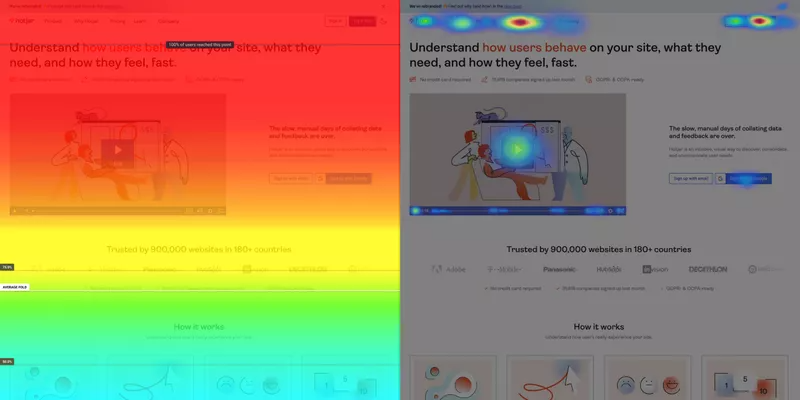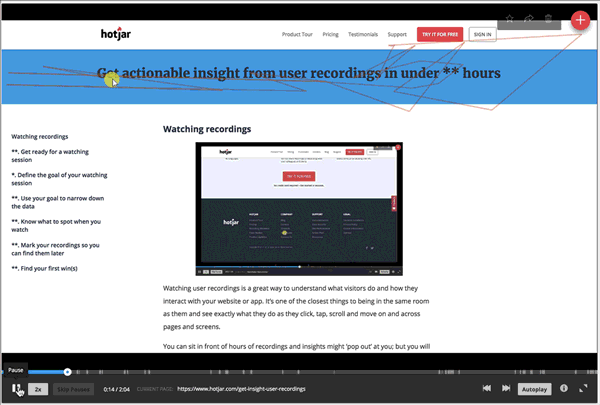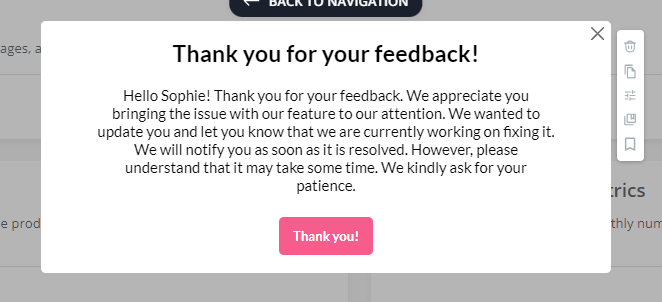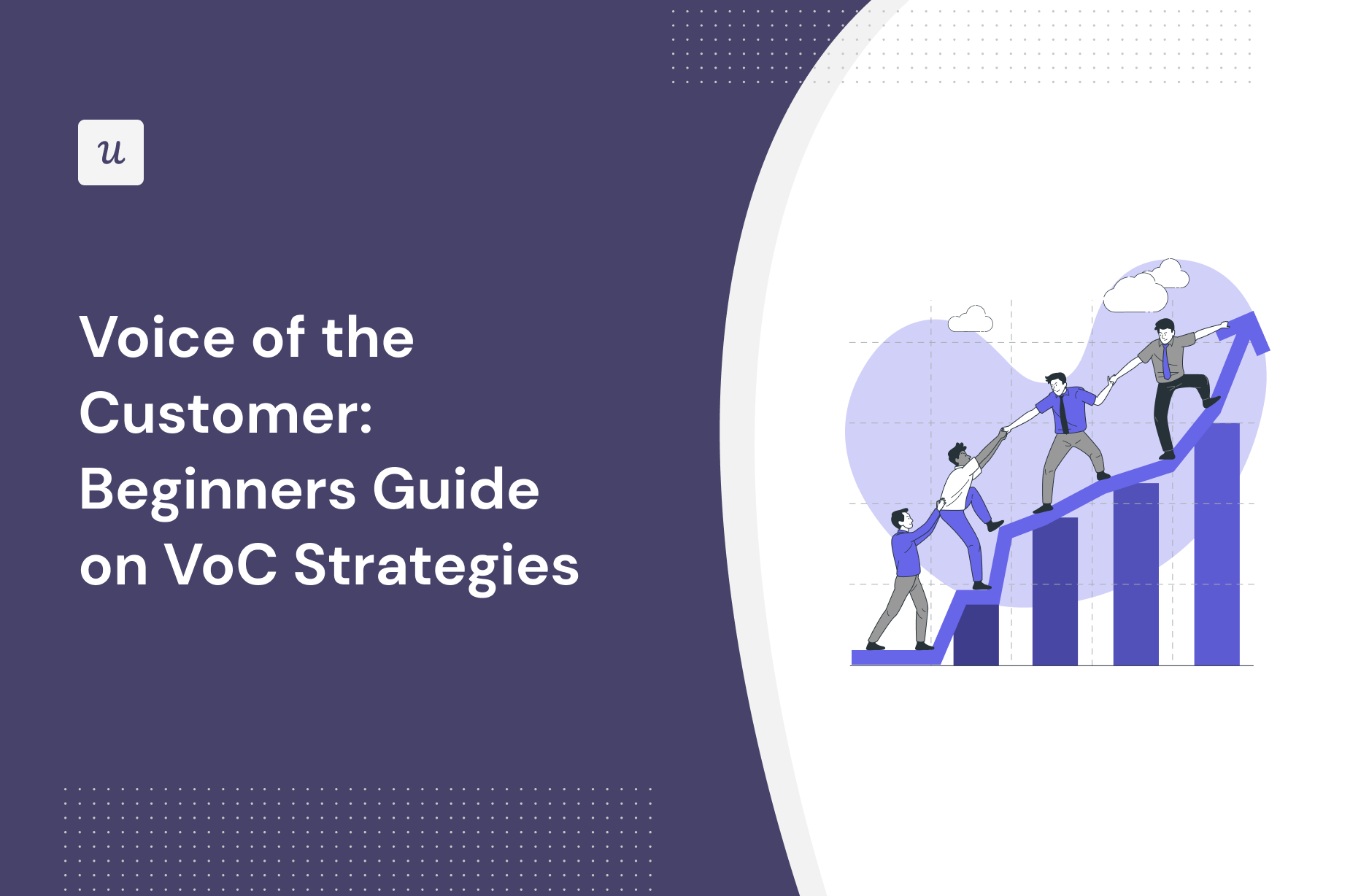
Are you just starting to put together a Voice of the Customer (VoC) program?
You’re in the right place.
There are a lot of both in-app tools and outside-the-app methods of collecting user sentiment data to understand what your users want, we’re going to show you how to create a VoC program and the best practices when it comes to collecting data.
Let’s dive in!
Try Userpilot Now
See Why 1,000+ Teams Choose Userpilot

What is Voice of the Customer (VoC)?
Voice of the customer (VoC) is the term used to describe the process of collecting feedback and user sentiment on your customer’s experience with your product.
Compared to the classic customer feedback data collection, often done in an aggregate form (all users), a Voice of the Customer program shifts the focus to a more granular level(individual users).
What do you do with the data you collect?
The Voice of the Customer data collected is the foundation of your VoC program.
A Voice of the Customer program is more than just gathering data. VoC program looks into capturing, analyzing, and acting upon individual customer feedback.
It’s about listening to your customer’s voices, understanding their needs and wants, and acting upon them to improve your product.
Why is Voice of the Customer important?
In short, the Voice of the Customer helps you build better relationships with your customers, which helps you improve your product.
Your goal should be to build a product that your users want to use because it brings value to them and exceeds customer expectations.
If your users are having a hard time using your product, you should make it a priority to find out why and remove those obstacles. If they are truly happy with your product, you should be looking into what’s making them happy and do more of that.
By having a Voc program in place, you can connect with your users at every stage of their journey and address the problems they might have to improve customer experience. This, in turn, can boost customer retention and foster customer loyalty.
A VoC program will give you answers to questions like:
- What are users trying to achieve by using your product? What are customer needs?
- What blocks users from becoming loyal customers?
- What are users expecting your product to do?
- What do users like about your product?
- What negatively impacts on customer satisfaction?
A VoC program focuses on specific questions, looking for specific answers, from specific users. Having this granular type of user insights helps your business improve the product in areas that matter most to the end-user.
How to build a successful customer experience program with VoC data
Sending out surveys and talking to customers might sound easy. Before getting to that, you must first plan your VoC program: What are you looking for and how are you going to get it?
So how exactly do you plan a VoC program?
Think of how Scrum and Kanban are two of the most widely used methodologies when it comes to Agile software development.
When looking to plan and implement a VoC program, you should be looking at the Six Sigma DMAIC methodology (DefineMeasureAnalyzeImproveControl):
- Define: What questions are you looking to answer? Which segment of your existing customers can give you those answers? What tactics/methods are you going to use to collect customer feedback? When during the customer journey is it best to ask those questions?
- Measure: Set metrics and KPIs you want to measure with your Voice of the customer feedback. For instance, Net Promoter Score (NPS) is a popular statistic for measuring customer loyalty. You can also use the customer satisfaction score, customer retention rates, and customer effort score.
- Analyze customer feedback: You can use different methods for analyzing customer feedback, such as comparing metrics over time, using survey analytics dashboards, tagging customer responses, and analyzing customer data.
- Improve your Voice of the Customer program: Improve customer satisfaction score and your VoC program based on the customer input. Incorporate the direct feedback from your customers to improve your product.
- Control: Build processes that solve the issues long-term.
The important thing to remember is to always understand the customer data you need to collect before you start collecting it.
This will dictate the best method to use to collect and address customer feedback.
How to collect VoC data
Any successful VoC program includes four key elements: Solicit customer feedback. This can be achieved in a variety of ways, from direct and indirect feedback to inferred feedback. Let’s dig into them.
Collect customer feedback with Net Promoter Score surveys
Net Promoter Score (NPS) surveys are a quick way of measuring how loyal and happy your customers are. No wonder this is one of the most used methods of collecting VoC data.
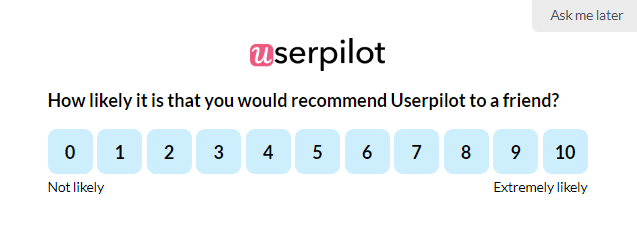
It’s easy to implement and doesn’t require much of your user’s attention and time, meaning they are more likely to engage and answer than they would with a long survey.
Through in-app NPS surveys, you can collect both quantitative and qualitative Voice of the Customer data:
- Quantitative VoC data by asking users to answer the question ”How likely are you to recommend our company to a friend or colleague?” on a scale of 0 to 10.
- Qualitative VoC data by asking them to justify their answer with a follow-up survey. This is an effective way of learning about customer pain points.
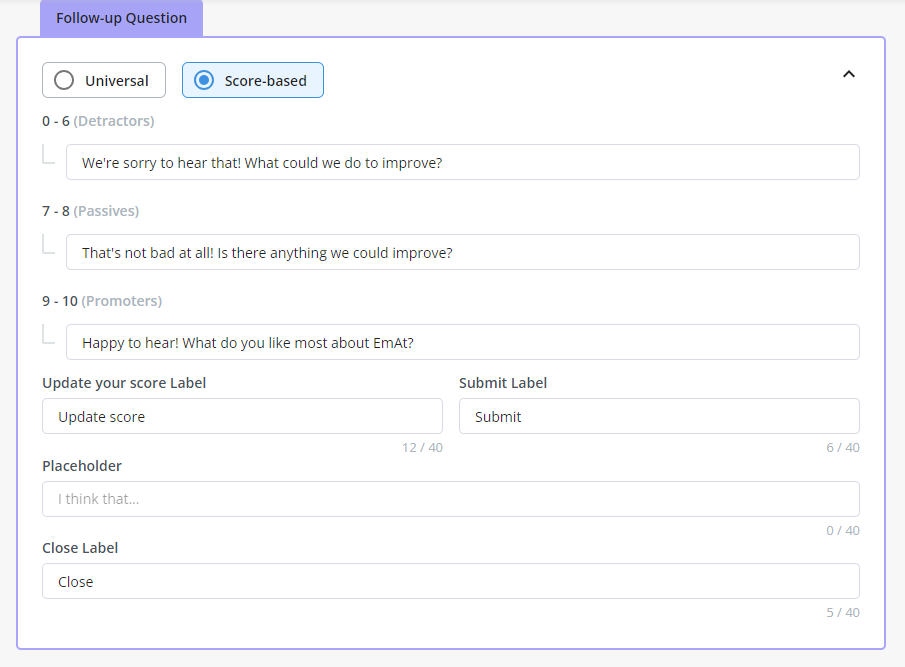
Keep in mind that when using in-app data collection methods, timing is essential.
As I mentioned previously in this article, before asking a user to respond to your NPS survey, decide at which moment of the user journey is it best to ask the question ”How likely are you to recommend our company to a friend or colleague?”
With mobile NPS, you can trigger existing and new NPS surveys directly within your mobile app, effortlessly gathering these valuable user insights on the go.
Gather feedback with in-app surveys
In-app surveys are a faster and more user-friendly way of getting VoC data compared to online surveys.
That’s because they are shorter and focus more on getting targeted feedback from your users.
Targeted and specific is the main purpose of a Voice of the Customer program.
You should use in-app micro surveys when looking to answer specific questions such as:
- What is the user trying to achieve by using your product (the outcome they are looking for)?
- How easy is it to use a feature and what’s the purpose of using it?
- Is there anything missing in your app?
- Why is the user canceling their account?
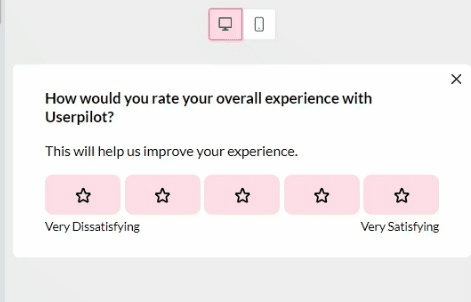
Collect VoC data with customer interviews
Sometimes it’s easier to understand how customers perceive your product when you have a quick call with them.
Customer interviews are one of the oldest methods of collecting VoC data.
You should use them when looking to gather in-depth feedback on your product. Not only you will gather relevant data, but in-person interviews will help build trust between you and your customer.
They are the most time-consuming VoC data collection technique so before you begin, define your focus groups.
A great way to do this is by looking at the in-app behavioral data we discussed above and identifying the most active users as they are likely to accept an interview.
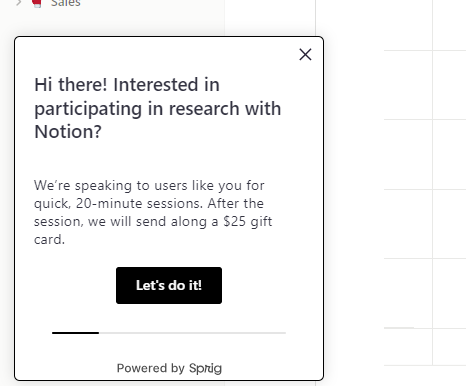
Collect VoC data through live in-app chat
You can gather direct and indirect feedback from your customers. Live chat is another way to tap into customer complaints.
It’s a great way to capture the Voice of your Customer data in real-time.
Even though a bit time-consuming, you can get valuable qualitative data by looking at what your users say when interacting with your customer service team via in-app chat.
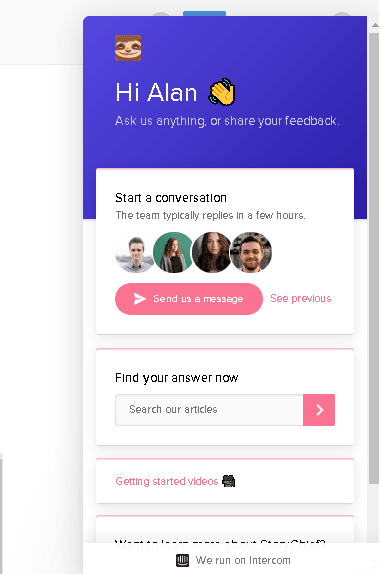
Collect VoC data with external online surveys
While in-app micro surveys are more user-orientated and specific, online surveys are more general and can help you get an overall picture of the Voice of the Customer.
Online surveys take longer to set up and analyze so it’s not an easy-to-use method.
You should use online surveys when you’re trying to understand how customer needs and expectations of your product change over time and what’s influencing it.
Online surveys are best for taking the pulse of your audience regularly, but I wouldn’t advise you to use them more than once per year. Replace them with contextual in-app microsurveys and you will get more relevant data for your VoC program.
Collect VoC data through social media listening
Collecting customer feedback shouldn’t only be done with surveys.
Social media listening is another great way to perform customer research and understand customer expectations.
Social media channels are where customers voice their opinions about your product, and potential customers listen and ask for recommendations. So you should make sure they share positive feedback.
Tracking brand mentions across social media channels will help you listen to what your customers are saying and join the conversation.
It can be a bit challenging to gather VoC data from social media platforms. But it’s worth including this method here as this is the type of data you don’t have to ask customers to provide, making it that more valuable.
Collect VoC data by analyzing online customer reviews
Similar to the VoC data collected on social media, online customer product reviews will provide a lot of customer insights.
Compared to social media data you usually have to ask customers to leave a product review and direct them to the website where they can do so.
Commonly used product review websites are Capterra, G2 Crowd, and TrustPilot. These websites track both a score (quantitative review) and a qualitative review divided into pros and cons sections.
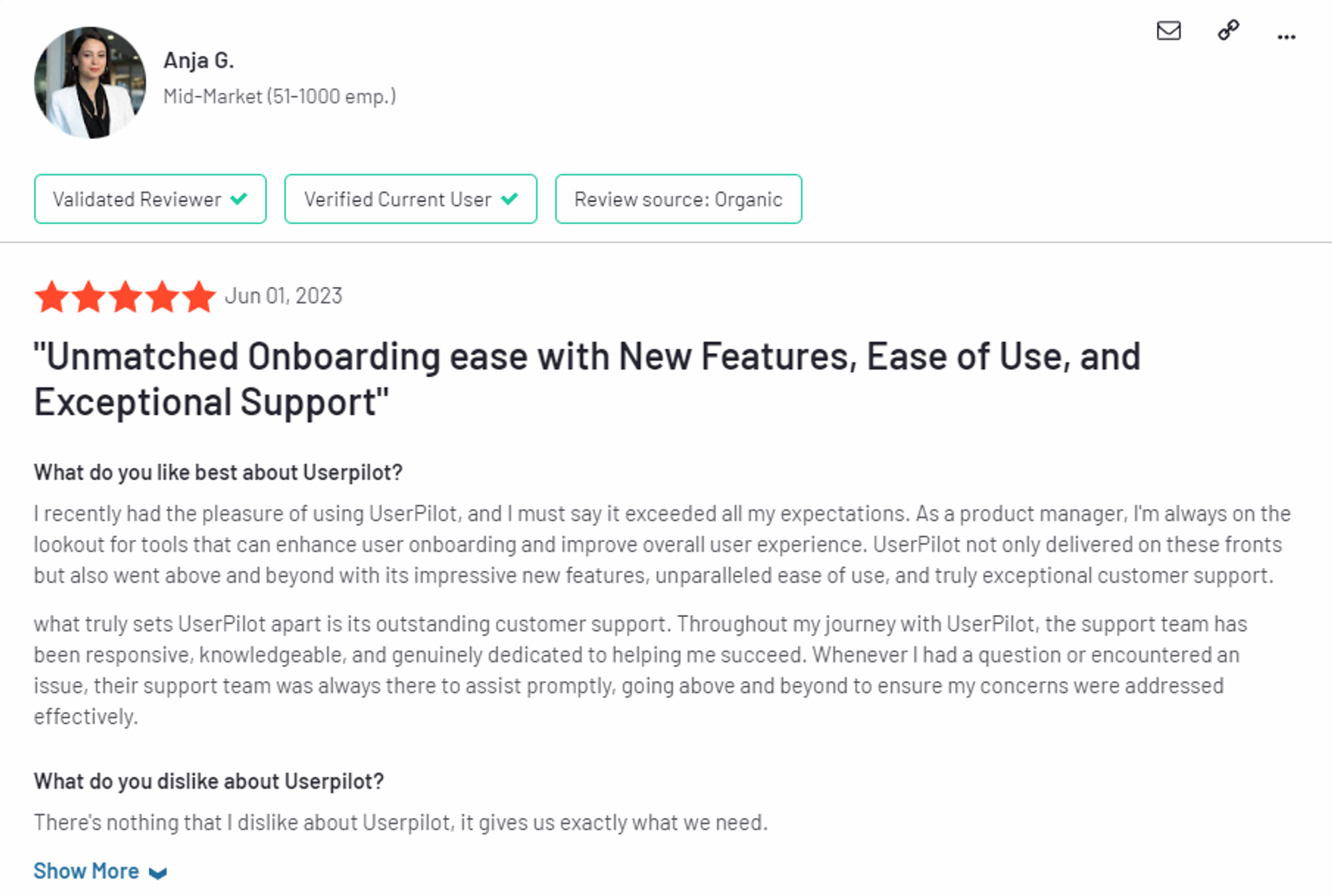
Collect VoC data by analyzing your user’s in-app behavior
Are you tracking how your users engage with your product across their journey?
Data is always the starting point of your VoC as it will tell you:
- Which are the right users to ask more in-depth questions?
- Where are the friction points and drop-off points in the user journey?
- Which features are bringing the most value to your users?
When it comes to in-app user journey analytics that is relevant to your Voice of the Customer program, you should look into behavioral analytics data.
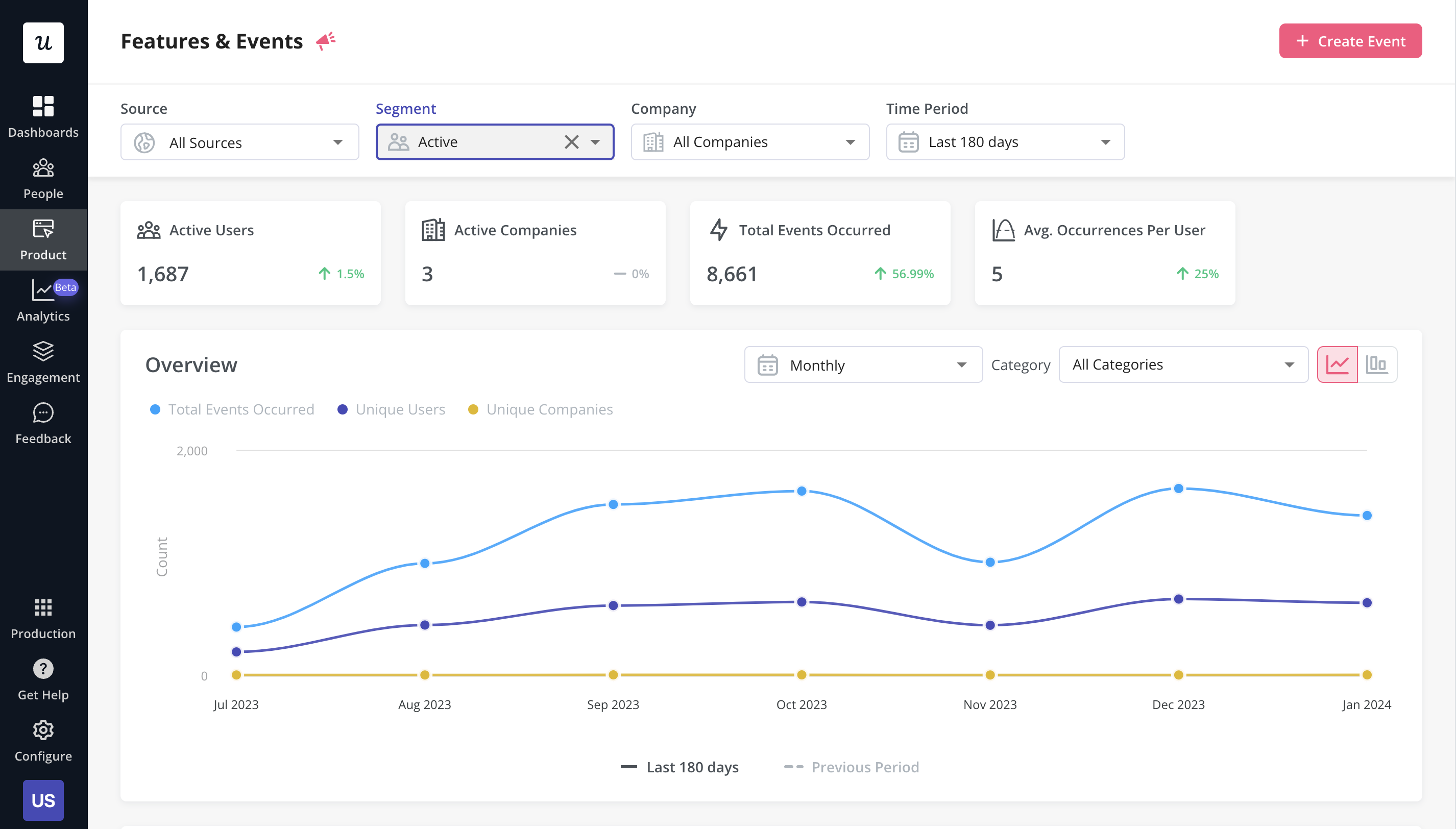
Collect VoC data by analyzing your customer website behavior
The Voice of the Customer doesn’t need to be always spoken. User’s actions can say a lot too and you can gather that insight by analyzing user behavior on your website.
Using heat map tools such as Hotjar, you can see what type of information your users are most looking at, what buttons they click, and what type of content they need before deciding to click the buy now button.
Hotjar can also be used to record in-app user sessions and to get to the bottom of a problem much faster than just looking at in-app feature usage.
Best practices to implement when creating your Voice of the Customer program
The Voice of the Customer provides early warnings and direction for your success, directly from the people who matter—your customers.
Employ these best practices to realize continuous improvement in your VoC program.
Think of the VoC program as a continuous process
If a customer is happy today, doesn’t mean he can’t experience a bad interaction with your product tomorrow.
By constantly gathering feedback and interacting with your customers, you make sure you stay connected to their wants and needs, making it easier to react and respond promptly.
Combine data collection methods and channels
Levels of insight vary depending on the method you choose when collecting VoC data.
The best practice is to always use different methods of collecting data that complement each other. This way you can get more granular and in-depth feedback.
For example, use an NPS in-app survey to collect real-time customer feedback. Follow up on your NPS with an email.
Plus, customers will always be sharing what they think about your product even when you don’t ask them to. Not listening to their voice on multiple channels can cause you to miss critical information that can affect your product retention.
Gather feedback at every stage of the user journey
Gathering Voice of the Customer data isn’t something you do once a year or a quarter.
And most importantly, it shouldn’t be time-based. Look at contextually collecting VoC data across the user journey.
Key points when you should be asking for feedback are:
- During onboarding.
- After the user interacts with a new feature.
- After interacting with your CS or support department.
- When the customer reaches a predefined milestone in the user journey.
- When the user behavior changes: becoming more engaged in using your product or signaling they might be churning.
Respond to customer feedback and close the feedback loop
You will probably not be able to incorporate every feedback you get into your product, but it’s important that your customer feels their opinion is being listened to.
Acknowledge that you listened and tell them what you will do about it. This way you will be setting the proper expectations and the customers will be more likely to share feedback with you in the future.
However, acknowledging and responding to feedback is the first step, but there’s no point in collecting the Voice of the Customer if you don’t act upon it.
Are your users complaining about bugs in the product? Do they desperately want a new feature? Adjusting your product map to take feedback into account will show your users that you value their feedback.
Don’t forget to keep them informed on the progress too.
Share the data between departments
Having a Voice of the Customer program is meant to help improve customer experience.
If the data you collect is not shared across your company, how can you get the big picture of what your users think about your product?
More so, every time a user interacts with a member of your team they shouldn’t be repeating the same problem just because they got assigned to a different team member.
Sharing insight between departments will help you understand the problem better and improve customer experience and satisfaction.
Conclusion
If you’ve reached the end of this article you should be ready to start collecting your Voice of the Customer data.
Be sure to make a checklist of best practices and mistakes to avoid so you can always make sure you are on the right track.
Brainstorm with your team a list of questions you need insights on and start collecting data using in-app or outside-the-app methods.
If you’re looking for a tool to help you with the in-app methods discussed in this article, Userpilot can help, get a free demo today!
Collect Customer Data In-app with Userpilot


